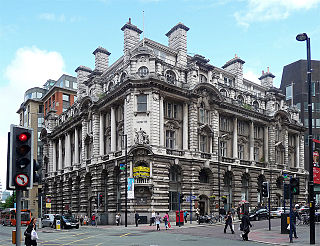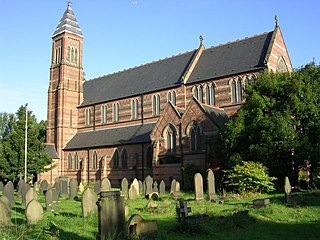
100 King Street, formerly the Midland Bank, is a former bank premises on King Street, Manchester, England. It was designed by Edwin Lutyens in 1928 and constructed in 1933–35. It is Lutyens' major work in Manchester and was designated a Grade II* listed building in 1974.

King Street is one of the most important thoroughfares of Manchester city centre, England. For much of the 20th century it was the centre of the north-west banking industry but it has become progressively dominated by expensive shops instead of large banks.

The Edgar Wood Centre is a former Church of Christ, Scientist building in Fallowfield, Manchester, England. The church was designed by Edgar Wood in 1903. Nikolaus Pevsner considered it "the only religious building in Lancashire that would be indispensable in a survey of twentieth century church design in all England." It is a Grade I listed building and has been on the Heritage at Risk Register published by Historic England.

Memorial Hall in Albert Square, Manchester, England, was constructed in 1863–1866 by Thomas Worthington. It was built to commemorate the bicentennial anniversary of the 1662 Act of Uniformity, when the secession of some 2,000 Anglican clergy led to the birth of Nonconformism It is a Grade II* listed building as of 14 February 1972.

Holy Trinity Platt Church, is in Platt Fields Park in Rusholme, Manchester, England. It is an active Anglican parish church in the deanery of Hulme, the archdeaconry of Manchester, and the diocese of Manchester. The church is recorded in the National Heritage List for England as a designated Grade II* listed building. It is the second "pot church" designed by Edmund Sharpe, so-called because the main building material used in the construction of the church is terracotta.

The former Manchester Law Library is a Grade II* listed building in the Venetian Gothic style at 14 Kennedy Street, Manchester. "The building is noteworthy by virtue of having been built for the purposes of a law library and, London and the old universities aside, it is believed to have performed this function for a period longer than any other provincial law library".

Charles H. Heathcote (1850–1938) was a British architect who practised in Manchester. He was articled to the church architects Charles Hansom, of Clifton, Bristol. He was awarded the RI Medal of Merit in 1868, and started his own practice in 1872.

Asia House at No. 82 Princess Street, Manchester, England, is an early 20th century packing and shipping warehouse built between 1906 and 1909 in an Edwardian Baroque style. It is a Grade II* listed building as at 3 October 1974. Nikolaus Pevsner's The Buildings of England describes the warehouse, and its companion, No. 86, Manchester House, as "quite splendid ... good examples of the warehouse type designed for multiple occupation by shipping merchants". It attributes its design to I.R.E. Birkett, architect of the Grade II listed companion building, Manchester House, which is similar in design. English Heritage attributes it to Harry S. Fairhurst. Asia House has an "exceptionally rich" entrance hall and stairwell, "lined with veined marble and green and cream faience, with designs of trees and Art Nouveau stained glass".

India House in Whitworth Street, Manchester, England, is a packing and shipping warehouse built in 1906 for Lloyd's Packing Warehouses Limited, which had, by merger, become the dominant commercial packing company in early-20th century Manchester. It is in the favoured Edwardian Baroque style and is steel-framed, with cladding of buff terracotta and red brick with buff terracotta dressings. It is a Grade II* listed building as of 3 October 1974.

The Reform Club in Spring Gardens, Manchester, England, is a former gentlemen's club of the Victorian era. Constructed in 1870–1871 in the Venetian Gothic style by Edward Salomons in collaboration with Irish architect John Philpot Jones, the club is "his best city centre building" and is a Grade II* listed building as of 3 October 1974. The contract for construction was awarded to "Mr Nield, builder, Manchester for £20,000". Built as a club house for Manchester's Liberal Party elite, the building was opened by Earl Granville, Gladstone's Foreign Secretary, on October 19, 1871. The building is constructed of sandstone ashlar with polychrome dressings and hipped slate roofs and is three-storey with elaborate corner turrets and oriel windows and balconies. The main entrance is "richly adorned with carving including winged beasts". The interior contains a "fine staircase, a (two-storey) grand dining room and an enormous billiard room, running the whole length of the building, in the roof". The "hall and staircase (have) linenfold panelling."

38 and 42 Mosley Street in Manchester, England, is a double-block Victorian bank constructed between 1862 and c. 1880 for the Manchester and Salford Bank. It was occupied in 2001 by the Royal Bank of Scotland. The original block of 1862 was the "last great work" of Edward Walters, and the extension of the 1880s was by his successors Barker and Ellis. It is a Grade II* listed building.

The Church of St Cross, Clayton, Manchester, is a Victorian church by William Butterfield, built in 1863–66. It was designated a grade II* listed building in 1963.

The Church of St John the Evangelist is in Waterloo Road, Cheetham Hill, Manchester, England. It is an active Anglican parish church in the deanery of North Manchester, the archdeaconry of Manchester, and the diocese of Manchester. The church is recorded in the National Heritage List for England as a designated Grade II* listed building.

Rochdale Town Hall is a Victorian-era municipal building in Rochdale, Greater Manchester, England. It is "widely recognised as being one of the finest municipal buildings in the country", and is recorded in the National Heritage List for England as a designated Grade I listed building. The Town Hall functions as the ceremonial headquarters of Rochdale Metropolitan Borough Council and houses local government departments, including the borough's civil registration office.

Portland Street is a street which runs from Piccadilly at its junction with Newton Street southwards to Oxford Street at its junction with Chepstow Street in Manchester, England. The major buildings of Portland Street include the largest former warehouse in the city centre, Watts Warehouse, the former Bank of England Building and other former warehouses on the corners of Princess Street.
33 Eastgate Street, Chester, at the corner of Eastgate Street and St Werburgh Street, Chester, England, was built in 1859–60 for the Chester Bank and, as of 2012, it continues in use as the NatWest Bank. It is recorded in the National Heritage List for England as a designated Grade II* listed building. It is in Neoclassical style, but was built at the time that the Black-and-white Revival was underway in the city, and was therefore the subject of much criticism for being "out of place". It consists of three storeys, with five bays on the Eastgate Street side, and three bays facing St Werburgh Street. The ground floor is rusticated with tall round-arched openings. On the side facing Eastgate Street the middle three bays of the upper storeys are occupied by a blank portico with four Corinthian columns supporting a pediment with modillion cornices. All the windows are sashes. The banking hall has a panelled ceiling carried on four Ionic columns.

The Theatre Royal in Manchester, England, opened in 1845. Situated next to the Free Trade Hall, it is the oldest surviving theatre in Manchester. It was commissioned by Mancunian businessman John Knowles who wanted a theatre venue in the city.

Spring Gardens is an important thoroughfare in Manchester city centre. This L-shaped street, formerly the centre of the north-west banking industry, has five Grade II listed buildings and is part of the Upper King Street conservation area.
Manchester is a city in Northwest England. The M2 postcode area of the city includes part of the city centre, including the Central Retail District. The postcode area contains 143 listed buildings that are recorded in the National Heritage List for England. Of these, five are listed at Grade I, the highest of the three grades, 16 are at Grade II*, the middle grade, and the others are at Grade II, the lowest grade.

Chadderton Town Hall is a municipal building on Middleton Road, Chadderton, Greater Manchester, England. The town hall, which was the headquarters of Chadderton Urban District Council, is a grade II listed building.























